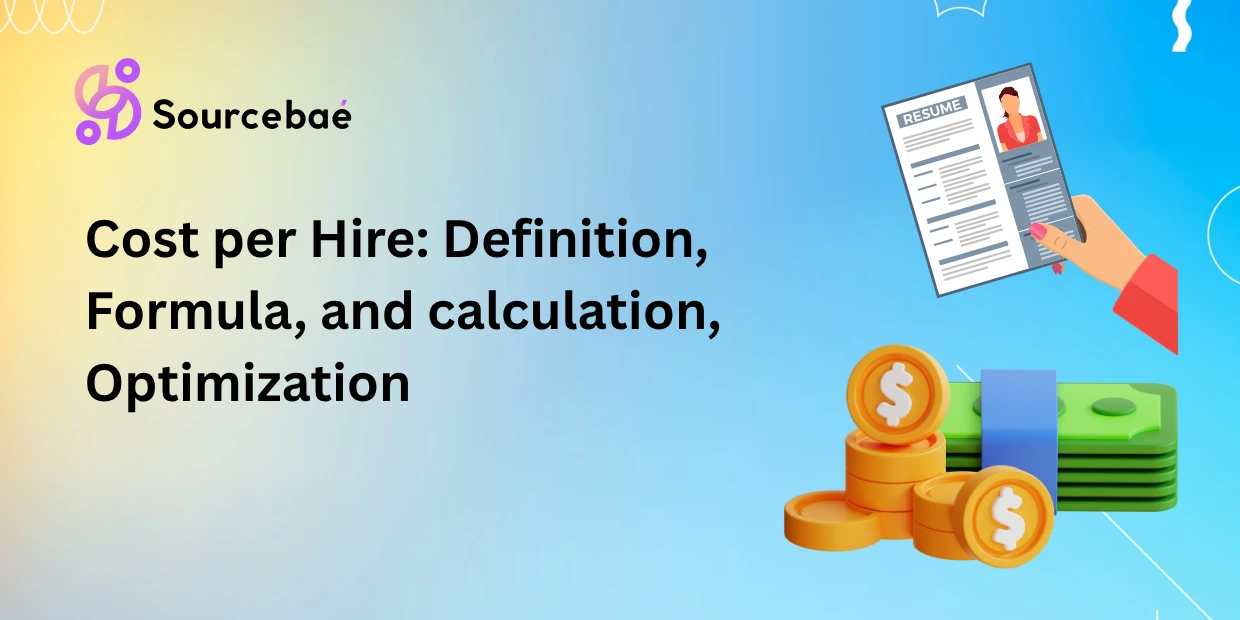Cost per hire is a key HR metric that measures the average recruiting expense required to fill a position. It encompasses all costs (internal and external) involved in attracting, screening, and onboarding new employees. In simple terms, cost per hire = (Total recruiting costs) ÷ (Number of hires). This guide explains what costs to include, how to calculate this metric step by step, why it matters, and how to lower it. We’ll use examples and data to illustrate the concepts and best practices for HR professionals and recruiters.
What is cost per hire?
Cost per hire (CPH) is the total expense of recruiting and hiring a new employee, averaged per hire. In practice, CPH includes all recruitment-related spending (advertising, agency fees, assessment tools, HR staff time, etc.) divided by the total number of new hires in a given period.
For example, if a company spends $100,000 on hiring activities in a year and brings in 20 new employees, its cost per hire is $5,000. This metric helps HR teams understand the real cost of hiring beyond just salaries. Unlike salary or benefits (ongoing costs), CPH focuses only on the upfront hiring expenses. (Industry data shows the “true cost” of bringing on a new employee can be 3–4× the salary, largely due to these recruiting costs.)
CPH is often calculated for a specific time frame (monthly, quarterly, or annually) and can be broken down by department, location, or hiring channel. It is used by organizations of all sizes to budget recruitment spend and evaluate hiring efficiency.
For instance, SHRM reports that the U.S. average cost per hire was about $4,700 in 2023. However, this figure varies widely: entry-level roles may cost just a few thousand dollars, while specialized or executive hires can run tens of thousands.
Cost per Hire Formula
The formula for cost per hire is straightforward:
Cost per Hire = (Total Internal Costs + Total External Costs) ÷ Total Number of Hires
- Internal costs are expenses incurred within the company during recruitment (e.g. HR/recruiter salaries, interview time of staff, employee referral bonuses, employer’s time spent on hiring tasks, office overhead for interviews, etc.).
- External costs are payments made outside the company for hiring (e.g. job advertising fees, recruiter or agency fees, background checks, pre-employment tests, relocation or signing bonuses, etc.).
- Total number of hires is simply how many new employees were onboarded during the period (often full-time hires, and sometimes excluding internal transfers or contractors, depending on your scope).
For example, consider a company’s one-month recruiting expenses. Suppose internal costs total $7,000 and external costs $16,500, and the company made 5 hires that month. Then:
- Internal costs = $7,000
- External costs = $16,500
- Number of hires = 5
Cost per hire = ($7,000 + $16,500) ÷ 5 = $4,700 per hire.
By tracking these numbers, HR can compute their CPH and compare it to benchmarks or past results.
Internal costs
Internal recruiting costs include all in-house expenses related to hiring. This typically covers:
- HR and recruiter salaries: The portion of internal staff time spent on recruiting (writing job descriptions, screening resumes, interviewing, etc.).
- Interview time and lost productivity: Hours managers and employees spend in interviews or onboarding instead of their usual duties (often overlooked “soft costs”).
- Technology and software: Costs of Applicant Tracking Systems (ATS), HRIS tools, or assessment platforms used in hiring.
- Employee referral bonuses: Rewards paid to employees for referring successful candidates.
- Recruitment event costs: In-house job fair booths, campus visit expenses, and related internal administration.
- Office space and equipment: Allocating meeting rooms or equipment for interviewing; this can be estimated as part of overhead.
- Onboarding or training materials: Some budgets treat new-hire orientation and training costs as part of hiring (though often this is a subsequent “onboarding” expense).
As an example, AIHR’s case study of a mid-sized company in October listed internal costs like sourcing ($2,000), recruiter salaries ($4,000), compliance checks ($500), and office equipment ($500), totaling $7,000. These illustrate the types of line items you would compile for internal costs.
External costs
External costs cover expenses paid to third parties or vendors during hiring. Common external costs include:
- Job advertising fees: Costs for posting jobs on boards (LinkedIn, Indeed, industry sites) or running ads.
- Recruitment agency or headhunter fees: Payments to third-party recruiters (often 15–25% of the hire’s salary).
- Background checks and pre-employment tests: Vendor fees for drug screens, criminal checks, assessment tools, etc.
- Technology/platform fees: Any outsourcing of hiring software or recruitment services.
- Recruitment marketing: Costs for employer branding campaigns or careers site enhancements.
- Travel and relocation: Candidate travel reimbursements (for interviews) and relocation packages for new hires.
- Miscellaneous vendor costs: e.g. contract recruiter stipends, campus recruiting agency fees, or subscription fees for niche job boards.
In the AIHR example, external costs included background checks ($2,500), pre-screening ($1,000), agency fees ($2,000), and marketing/technology ($5,000), totaling $16,500 for the month.
Total number of hires
This is simply the count of new employees hired in the chosen period (week, month, quarter, or year). Include full-time and part-time hires as defined by your scope; some companies also include contract or temporary hires, while others focus only on permanent staff.
Decide upfront which hires to count. For example, AIHR notes you might exclude transfers or employees on third-party payroll.
Once you have your total internal and external costs and your hire count, plug them into the formula above.
How do you calculate cost per hire?
Calculating cost per hire involves four main steps, as illustrated by AIHR’s methodology:
- Gather your cost data: Obtain accounting or expense reports for the period of interest. Identify all recruitment-related spending. It may help to work with finance to isolate hiring expenses.
- Identify and sum internal costs: Tally up all in-house costs (recruiters’/HR staff salaries, interview time, tools, equipment, etc.) into one total. For example, a company might find internal costs amount to $7,000 for October.
- Identify and sum external costs: Similarly, compile all outside expenses (job board ads, agency fees, screenings, etc.). In the example, external costs were $16,500 for October.
- Complete the calculation: Add the internal and external totals, then divide by the number of hires in that period.
For instance, if October had 5 new hires, the calculation is:
- Total internal = $7,000
- Total external = $16,500
- Number of hires = 5
Cost per hire = ($7,000 + $16,500) ÷ 5 = $4,700.
This result can be compared to benchmarks (e.g. SHRM’s industry medians) or past periods to evaluate whether your recruiting costs are rising or falling.
Example: Internal vs External Costs
| Internal Costs | Cost | External Costs | Cost |
|---|---|---|---|
| Job postings/sourcing | $2,000 | Background checks | $2,500 |
| HR/recruitment team salaries | $4,000 | Pre-screening/assessments | $1,000 |
| Compliance & admin | $500 | Agency/recruiter fees | $2,000 |
| Office equipment & supplies | $500 | Marketing/tech tools | $5,000 |
| Total | $7,000 | Total | $16,500 |
Example breakdown of internal vs. external hiring costs (October). (Source: AIHR).
After summing these, the cost per hire is calculated by (7000+16500)/5 = $4,700 (with 5 hires in that month).
Why is cost per hire an important metric?
Cost per hire is crucial for managing and optimizing recruiting efforts. Key reasons to track CPH include:
- Budgeting and forecasting: Knowing your CPH helps you plan HR budgets and forecast recruitment spend. It shows exactly how much recruiting will cost, enabling smarter financial planning. For example, tracking CPH can reveal that recruiting is consuming an unexpectedly large part of the HR budget, prompting a review of processes.
- Process improvement: Analyzing CPH highlights inefficiencies or expensive steps in hiring. If your CPH is rising, HR can drill into which costs (agency fees, ads, wasted interviews, etc.) are spiking and adjust accordingly.
- Performance benchmarking: CPH lets you compare performance over time or between teams. It can indicate whether your recruiting is more or less efficient than industry averages or peer groups. For instance, if one department’s CPH is significantly higher, it may need new hiring strategies.
- Measuring ROI of recruiting methods: By segmenting costs (internal vs. external or by channel), you can assess which methods give the best return. For example, tracking CPH by source may show that employee referrals yield candidates at much lower cost, justifying stronger referral programs.
- Ensuring cost-effectiveness: A dramatically high CPH could signal waste or that you’re over-paying for certain hires. (Conversely, a “too low” CPH might suggest cutting corners, which could hurt quality.) CPH provides a reality check on recruiting investments.
As an example of the impact, AIHR reports that Ericsson reduced its cost per hire by 70% through enhanced social media and employee advocacy recruiting. Likewise, Nokia cut its CPH by 74% by optimizing its online job postings with Indeed. These cases show how tracking CPH can lead to targeted strategies that significantly lower hiring costs.
Factors that affect the cost per hire
Figure: Key factors that influence the cost per hire, including role level, industry, location, and company size.
Many variables influence how high or low cost per hire will be for your organization:
Role complexity and level:
Senior, executive, or highly specialized roles typically cost more to fill. They often require paid headhunters, extensive interviews, relocation, and longer search times. In fact, average CPH for executive positions can approach $28,000, far above the $2–3K typical for entry-level roles.
Industry and talent market:
Industries with severe skill shortages (like tech, healthcare, or engineering) see higher CPH because demand outstrips supply. Engagedly notes tech hires often cost $6–10K each, and healthcare $9–12K. Geographic location also matters (hiring in expensive cities or remote markets can be costlier).
Recruitment channels used:
Hiring via agencies or paid ads adds significant external cost, while leveraging internal recruiters and referrals is generally cheaper. The mix of channels (and their efficiency) will sway CPH.
Hiring volume:
High-volume or campus recruiting can sometimes lower per-hire costs due to economies of scale (bulk postings, standardized processes). Conversely, recruiting only a few niche roles can inflate CPH.
Employer brand and sourcing strategy:
Organizations with strong employer brands (excellent reputation) often spend less per hire, since candidates come organically. Companies with weak brands may rely on pricey ads or agencies. (LinkedIn data shows companies with strong brands have ~43% lower CPH.)
Internal efficiency:
Long time-to-fill and extensive interview processes raise costs (more ad renewals, more staff hours). A slow hiring process can add “soft costs” from lost productivity. In fact, soft costs (onboarding time, lost work hours) can double or triple the apparent hiring cost.
Training and onboarding:
Investing heavily in onboarding (detailed training programs, mentors, equipment) raises initial hire costs, though it may improve retention in the long run.
Market conditions:
Economic factors (like low unemployment) and changing work trends (remote work, contract staffing) also affect CPH by altering supply/demand and the recruitment methods used.
In summary, CPH is not a fixed number – it depends on context. Smaller companies or those hiring mainly junior staff will have lower CPH, while large firms filling executive or specialized roles will see higher values. Always interpret your CPH in light of these factors.
How to optimize your cost per hire
To lower cost per hire without sacrificing candidate quality, consider these proven strategies:
Improve job quality and targeting:
Focus on attracting qualified candidates rather than a high volume of unqualified ones. Write clear, concise job descriptions and use targeted job boards or niche sites to reach the right audience. This reduces the time spent sorting resumes.
Strengthen employer branding:
Invest in your employer brand. Companies with strong brands have been shown to cut CPH dramatically (for example, one study found brands 43% lower CPH). Promote your company culture and success stories on social media and careers pages to attract candidates organically.
Leverage employee referrals:
Encourage and reward employee referrals. Referral hires often cost much less (CareerBuilder reports referral programs can lower CPH by ~25%) and tend to stay longer. A robust referral program can become a steady, low-cost hiring channel.
Use an Applicant Tracking System (ATS):
Automate administrative tasks (resume screening, interview scheduling, candidate tracking) with an ATS. This cuts down on manual effort and reduces missed or duplicated work. For example, video interview platforms have been linked to ~20% lower CPH by avoiding travel costs and speeding up screening.
Conduct virtual interviews:
Move phone or in-person screens to video. This saves on logistics and expands candidate reach. As noted, organizations using video interviews have significantly lower hiring costs.
Build talent pipelines:
Maintain a pool of pre-screened candidates for future openings. This “evergreen” pipeline (including past applicants, internships alumni, or networking contacts) can drastically cut time-to-hire and external ad spend when positions open.
Optimize spending on ads and agencies:
Regularly review which job boards or recruiters are yielding results. Shift budget away from low-performing channels. For instance, Nokia cut CPH by 74% after making Indeed its preferred job platform.
Monitor and analyze metrics:
Track your CPH alongside related metrics (time-to-fill, source effectiveness). Data-driven adjustments (e.g. doubling down on sources with lowest cost-per-hire) will steadily improve efficiency.
Focus on quality of hire:
Remember that cutting costs shouldn’t mean cutting corners. A bad hire can cost the company far more in productivity loss and re-hiring (often 3–4 times the position’s salary). Invest slightly more in screening good candidates to reduce turnover and, ultimately, hiring frequency.
Case in point:
Ericsson reduced its CPH by 70% through smart social and employee referral campaigns. Similarly, Nokia saved $1,100 per hire by insourcing many roles and using Indeed efficiently. These examples show that targeted changes in recruiting strategy can yield huge savings.
To sum up
Cost per hire is a vital recruiting metric that captures the efficiency of your hiring process. It is calculated by adding up all internal and external hiring expenses and dividing by the number of new hires.
By tracking CPH, HR teams can budget accurately, spot expensive bottlenecks, and compare their performance to industry benchmarks.
Remember to include both hard costs (ads, fees, salaries for recruiters) and soft costs (interview time, onboarding) for the clearest picture of your actual expense.
However, there is no one-size-fits-all “good” number—what matters is understanding what drives your specific costs.
Roles that are senior or in high-demand fields will naturally push up CPH, while large-scale campus hiring may bring it down. Use CPH not as an end in itself, but as a tool to guide strategy. A well-optimized process might involve stronger employer branding, more automation, and a focus on candidate quality.
Ultimately, reducing cost per hire should go hand in hand with improving hire quality and retention. Leaner recruiting budgets mean little if they lead to bad hires.
By continuously measuring CPH and experimenting with smarter recruitment tactics, HR professionals can strike the right balance between cost efficiency and hiring excellent people.
FAQ
What should be included in the cost per hire?
Answer: Include all recruiting-related costs, both internal and external. Internal costs cover things like recruiter/HR salaries, time managers spend interviewing, office space, and recruitment software. External costs include job advertising fees, agency or recruiter fees, background checks, assessments, relocation, and so on.
Essentially, any direct expense needed to fill a job goes into CPH. Note: the new hire’s salary and benefits themselves are not included in cost-per-hire; those are ongoing compensation costs. The CPH metric focuses on the one-time hiring costs. (In fact, studies show the total “true cost” of hiring – including lost productivity – can be 3–4× the salary, meaning if you included salary it would dwarf the recruiting costs. But standard CPH excludes salary.)
How is the cost per hire calculated?
Answer: Cost per hire is calculated by dividing the total recruiting costs by the number of hires in a period. In formula form:
Cost per Hire = (Total Internal Hiring Costs + Total External Hiring Costs) / Total Number of Hires.
For example, if you spent $10,000 on internal costs (staff time, ads, tools) and $30,000 on external costs (agencies, background checks) in one year, and hired 20 people, then CPH = ($10,000 + $30,000) / 20 = $2,000 per hire.
What is the average cost per hire in 2025?
Answer: Recent data shows the U.S. average cost per hire is in the mid-$4,000 range. For instance, SHRM and industry reports indicate an average around $4,700 per hire in 2023–2025. Keep in mind this is an average across all industries. In reality, CPH can be much lower for entry-level jobs (around $2,000–$3,000) and much higher for specialized or executive roles (easily $6,000–$12,000 or more, with executives ~$28,000).
Does the cost per hire include salary?
Answer: No, cost per hire typically excludes the new employee’s salary and standard benefits. CPH is meant to capture the recruiting-specific expenses only. (If you want a “total cost of hire” including salary and training, that’s a different calculation.)
Industry studies note that the complete cost of hiring an employee – salary plus all recruitment and onboarding costs – can be several times the salary. But when HR calculates cost per hire, they generally count only recruiting costs like advertising, fees, assessments, and staff time, not the hire’s compensation.
Why is cost per hire important?
Answer: Cost per hire is important because it directly connects recruitment spending to business outcomes. It helps HR and finance plan and control the recruiting budget, identify where money is being spent, and see if hiring processes are efficient. A well-managed CPH means you’re getting value for your recruiting dollars.
Tracking CPH allows you to benchmark against industry averages, spot when costs are rising, and justify or adjust hiring spend. It also highlights which recruitment methods are working best (for example, seeing that employee referrals are cheaper than job ads). In short, knowing your CPH helps make recruiting more data-driven and cost-effective. (And as noted, companies like Ericsson and Nokia have used CPH insights to dramatically cut their hiring expenses.)






